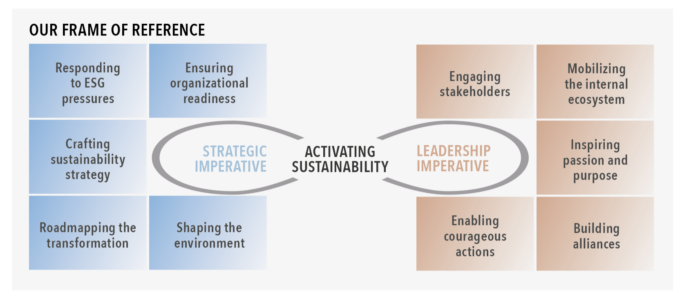Organizations need to take actions on both strategic and leadership dimensions of sustainability transformations to achieve impact.
Why do most business transformation initiatives fail? Often, organizations focus only on the strategic reasons for change and ignore the leadership and change elements of how the transformation is to be delivered. While business leaders are usually clear on the logic of sustainable transformation, they often fail to create the engagement needed to drive the change they want to achieve.
All these elements are essential for any kind of transformation to succeed. You need a combination of the head, or the logic of transformation, and the heart and hands, or the leadership of transformation, to get your organization to mobilize around the change. And this is particularly true when it comes to sustainability, which requires fundamental transformation for most companies.
Strategists in many organizations tend to focus on the factual rationale for innovation and change, but this approach ignores the vital importance of the need to bring people along with you, both inside the organization and in the external ecosystem. And yet it is this leadership part of the equation that really drives change. Both elements need to be combined if businesses are going to play a full part in shaping the future and creating a more sustainable world.
Transformation requires strategic imperative and leadership
When organizations concentrate only on the strategic side of the picture, the transformation initiative tends to happen in a vacuum, with an expectation that change will happen automatically once the initiative is announced, but research shows that this rarely happens in reality. Such an approach misses out a whole range of actions needed to ensure that people are inspired to get behind the initiative.
Yet, focusing only on the leadership aspects of transformation will not work if the strategic imperative for change is not present. Take the example of the aviation sector, where some organizations are making a push to adopt sustainable aviation fuels, even though these are still up to five times the price of regular aviation fuels. Even if you deploy all of the leadership tools at your disposal, any change is going to be limited and very slow until the underlying production technologies improve so that sustainable aviation fuels become more cost competitive.
Recent academic research showed the importance of the two – clarity in direction (the head) and corporate purpose (the heart and hands) – for financial performance. Using data from the Great Place to Work Institute’s surveys, the authors found that those companies that were rated “high” by their middle management and salaried employees on both corporate purpose and clarity in direction achieve a significant improvement in financial performance over time. However, the authors were unclear about the causal mechanisms behind this process. We decided to shed some light on the forces at play and explain how they operate in the area of sustainability.

Audio available








